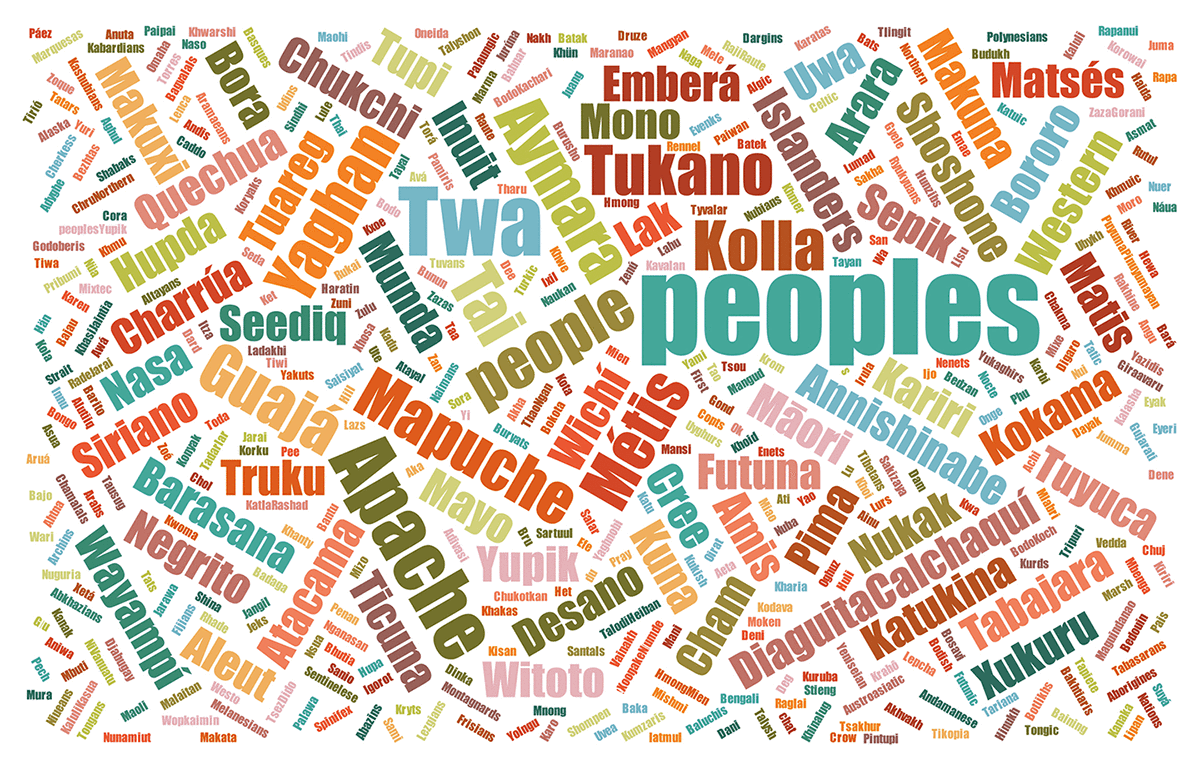The Issues
Called Tribal Peoples, First Peoples, Native Peoples, and Indigenous Peoples, these original inhabitants call themselves by many names in their 4,000 + unique languages and constitute about 6.2 percent of the world’s population.

According to the International Labour Organization, there are approximately 476.6 million Indigenous people in the world, belonging to 5,000 different groups, in 90 countries worldwide. Indigenous people live in every region of the world, but about 70 percent live in Asia and the Pacific, followed by 16.3 percent in Africa, 11.5 percent in Latin America and the Caribbean, 1.6 percent in Northern America, and 0.1 percent in Europe and Central Asia.
There is no universally accepted definition for “Indigenous,” though there are characteristics that tend to be common among Indigenous Peoples:
- Indigenous People are distinct populations relative to the dominant post-colonial culture of their country. They are often minority populations within the current post-colonial nations states. In Bolivia and Guatemala Indigenous people make up more than half the population.
- Indigenous People usually have (or had) their own language, cultures, and traditions influenced by living relationships with their ancestral homelands. Today, Indigenous people speak some 4,000 languages.
- Indigenous People have distinctive cultural traditions that are still practiced.
- Indigenous People have (or had) their own land and territory, to which they are tied in myriad ways.
- Indigenous People self-identify as Indigenous.
Examples of Indigenous Peoples include the Inuit of the Arctic, the White Mountain Apache of Arizona, the Yanomami and the Tupi People of the Amazon, traditional pastoralists like the Maasai in East Africa, and tribal peoples like the Bontoc people of the mountainous region of the Philippines.
Political action
The international human rights mechanisms – including: the United Nations Permanent Forum on Indigenous Peoples Issues (UNPFII); the Expert Mechanism on the Rights of Indigenous Peoples; the UN Declaration on the Rights of Indigenous Peoples (UNDRIP); the Universal Periodic Review (UPR); and several Treaty Bodies and Special Procedures – serve in part to provide legal mechanisms for Indigenous Peoples to protect their rights (for example, the right to Free, Prior, Informed Consent (FPIC) - a key concept for self-determination and protecting Indigenous lands.) These entities, policies, and procedures present key opportunities for Indigenous Peoples to speak and advocate for themselves, their cultures, their lands, and their lifeways when state and local governments fail to honor and protect their rights.
Communication strategies
Radio’s universal and free nature and its ability to access many remote communities makes it a key medium to reach Indigenous audiences. Indigenous-produced programming strengthens Indigenous peoples’ capacity to assert and demand their rights and enables access to information on climate change, environmental issues, women’s rights, education, languages and cultures, self-determination, and Free, Prior and Informed Consent. Cultural Survival’s partners are amplifying Indigenous voices on issues that matter to their communities. Broadcasting in Indigenous languages ensures widespread understanding and cultural continuity.
Indigenous Peoples and the Environment
It is estimated that Indigenous territories contain 80 percent of the Earth’s biodiversity. Indigenous lands also hold unquantified megatons of sequestered carbon as 11 percent of the planet’s forests are under their guardianship. These regions face an unprecedented and rapid loss of biodiversity and climate change effects resulting from the fossil fuel-based industrialized global economy and natural resource extraction. Many traditional Indigenous lands have become biodiversity “hotspots.” For Indigenous Peoples, conservation of biodiversity is an integral part of their lives and is viewed as spiritual and functional foundations for their identities and cultures. It is no coincidence that when the World Wildlife Fund listed the top 200 areas with the highest and most threatened biodiversity, they found that 95 percent are on Indigenous territories.
Indigenous Peoples and the environments they maintain are increasingly under assault from extractive industries such as mining, oil exploration, logging, and agro-industrial projects.
Indigenous Peoples resist this invasion with tremendous courage and skill, but their protests are too often ignored by governments and corporations.
Extractive industries
It is no coincidence that 80 percent of the earth’s biodiversity is found on Indigenous lands. It is because of Indigenous people’s stewardship and relationship with the environment. However, governments in Indigenous Peoples’ homelands and multinational corporations too often violate Indigenous Peoples’ rights by operating in their territories without their Free, Prior and Informed Consent... Often culturally, linguistically and geographically separate from mainstream cultures, Indigenous Peoples lack the financial resources and access to decision-making platforms to demand a voice at the table and ensure that their best interests are represented. Indigenous Peoples, having exhausted avenues in seeking justice and protection of their rights at the national level, can choose to seek international pressure and attention to their plights.
This is where Cultural Survival comes in.
With your support, Cultural Survival empowers and supports Indigenous Peoples to advocate for their rights — human rights, the right to participate and have a voice, the right to practice their cultures and speak their languages, the right to access the same opportunities as others, and the right to control and sustainably manage their assets and resources — so that they may determine for themselves the future they will lead.
